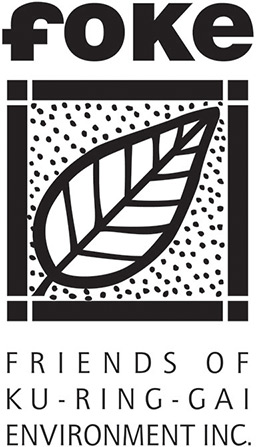
NSW biodiversity is in decline.
This dire future is outlined in the NSW Government’s NSW biodiversity outlook report 2024 released on 8 May 2024.

Knowing that fully half of our threatened species are on track to imminent extinction, how can any government support the destruction of Ku-ring-gai’s biodiversity?
This NSW biodiversity outlook report 2024 predicts a sombre future. At least half of the species currently listed as threatened in NSW will be extinct within a century. Already too much natural habitat has been lost forever. Yet ‘business as usual’ habitat clearance continues to accelerate to drive biodiversity collapse. We urgently need to protect our remaining natural habitats and invest in massive restoration programs to give our native species the homes they need to survive. Is this happening in Ku-ring-gai? No.

Five days following the publication of the NSW biodiversity outlook report 2024 the NSW Government’s Transport Orientated Development (TOD) policies came into effect in Ku-ring-gai on 13 May 2024.
Four TODs were placed in Ku-ring-gai. Four TODs were placed in one of Greater Sydney’s most environmentally sensitive areas -along a narrow strip of land in Ku-ring-gai between Roseville and Gordon. This railway corridor land is identified as ‘environmentally sensitive’.
Four hundred metres around Roseville, Lindfield, Killara and Gordon railway stations were circled for high rise – without any consideration of its environmental ramifications. This was part of the Minns government’s ‘amendments ‘one size fails all’ State Environmental Planning Policies to build high density residential precincts around railway stations. No justification was provided for why these four environmental sites were chosen. Why? ‘Cabinet in Confidence’. Communities had no say in this massive rezoning agenda.
The massive rezoning densification frenzy across Greater Sydney is at unprecedented levels. and will accelerate excessive land clearing leading to habitat loss – the biggest driver of extinction.
Since 2016 with the implementation of the NSW Biodiversity Conservation Act land clearing of native vegetation in rural areas has accelerated. The NSW Government’s own data show almost 100,000 hectares of native vegetation was cleared every year after the act was introduced in 2016. Then there was the 2019-2020 Summer Black Bushfires that killed a billion wildlife. Now land clearing is being planned for Ku-ring-gai’s urban forests, particularly its critically endangered Blue Gum High Forest. ecological community.
Ku-ring-gai has two critically endangered communities and four endangered ecological communities.
NSW has one of the worst land clearing rates in the world.
Australia is a signatory to the Kunming-Montreal Global Biodiversity Framework (GBF) that pledges ambitious targets for the restoration and protection of the natural landscape. Yet our current environmental and planning laws make achieving these goals impossible.
New environmental legislation is needed.
The NSW Minns Government have promised to reform the Biodiversity Conservation Act 2016 and the native vegetation provisions of the Local Land Services Act 2013, following a scathing independent review in 2023 by Dr Ken Henry in August 2023. Despite saying that NSW will put “biodiversity protections . . . front and centre” it is at the same time prioritising housing reforms that will accelerate land clearing in one of Greater Sydney’s most biodiverse local government areas – Ku-ring-gai.
In July 2024 the NSW Government published its ‘NSW plan for nature‘ which outlined its response to the reviews of the Biodiversity Conservation Act 2016 and the native vegetation provisions of the Local Land Services Act 2013. It’s state goal is “to leave nature better off than we found it”. However, it blithely ignored the environmental damage caused by the TOD SEPP that will decimate Ku-ring-gai’s natural environment., if approved. That is why FOKE has strongly supported Ku-ring-gai Council’s legal action against the NSW Government’s TOD program.
Environmental reforms need to:
- firm ‘NO’ to environmentally damaging developments
- stop the clearing of native vegetation and trees
- maintain and restore carbon-rich trees as a climate solution
- prohibit loss of significant habitats
- stop land clearing
- mandate ‘no’ to environmentally damaging developments
- implement sustainable planning policies
- map High Conservation Values to guide planning decision-makers
- implement ‘development no-go zones’
- restore forest canopy cover at scale through widespread tree planting
- restoring degraded bushland
- removing introduced species
- recognise that the Black Summer Bushfires of 2019–20 have significantly contributed to NSW’s biodiversity decline.
There are several key findings in the NSW biodiversity outlook report 2024 report:
- only 50% of threatened species are expected to survive the next 100 years
- only 29% of the capacity of habitat to support native species remains
- past habitat loss and future climate change will significantly reduce the capacity of landscapes to retain biodiversity over the next 50 years
Resources
Interview with Biodiversity Council Director James Trezise with ABC Radio HERE
National Parks Association of NSW ‘Nature NSW, Winter 2024 HERE

Stay in Touch
Sign up for FOKE E-News HERE
info@foke.org.au
https://www.facebook.com/friendsofkuringgai/
Authorised by K. Cowley, 1 Kenilworth Road, Lindfield, NSW, 2070
